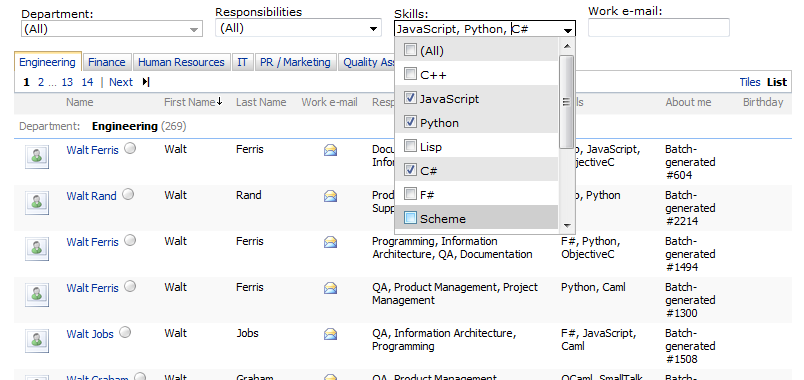Filtering, Tabbing and Search
Global User Name Filter
There are certain user accounts that you probably never want PeopleZen to show under any circumstances. You can filter these out "globally", ie. on the farm level or on the Site Collection level. This is done via the Exclude User Names configuration setting available via Site Settings / PeopleZen Studio / Configuration Settings, where you specify fully qualified domain account names to exclude, or describe a range of user names with *wild-card* patterns.
Simple Built-In Filtering
Select Edit Web Part from the PeopleZen Web Part menu and in the settings tool-pane, you will find the Filtering section:
A simple way to let end-users quickly filter by a given primary user profile property is the built in Quick-Filter Tabs feature. Simply select that property in the drop-down menu labeled Show tabs to quickly filter by. If you select the Department property, for example, PeopleZen provides tabs that correspond to the existing data values, and each tab shows only user profiles matching the implied filter:
This works well for user profile properties with a limited number of repeatedly used values, such as Department (where realistically between 3 and 20 values will exist), Skills, Past Projects, Manager etc. However, this feature has a neat way of also working well with properties of a potentially vast set of values, such as user names (as many values as user profiles will exist), phone numbers, birthdays etc. Beyond a certain threshold number of unique values (the default is 16), instead of providing each value as a separate tab, groups of values are subsumed under alphabetical, numerical or chronological index tabs:
To use quick-filter tabs, you need to pre-define a user profile property to filter by, but if you want end-users to change this interactively on-the-fly, simply tick the Allow interactive ad-hoc change of that property check-box option.
You will notice in the above screenshots that a tab simply labeled "—" may be shown at the end that shows all user profiles where the quick-filter tabs user profile property has no values at all. You can hide these people using the Always hide the [Empty] quick-filter tab configuration setting. You can also choose to show the PeopleZen Web Part initially-unfiltered by prepending to your quick-filter tabs a tab (to be selected-by-default) labeled (All), using the Always show the [All] quick-filter tab configuration setting.
Other options in the Filtering section:
- Ignore year when filtering by date properties — tick this check-box option only when filtering (via quick-filter tabs or Web Part Connections) by a user profile property of the type date no year, such as SPS-Birthday. This ignores the year both from the property value and the filter value when performing the filtering.
- Ajax-based live filtering — this check-box option controls how filter values
sent via a Web Part connection with a FilterZen Filter Web Part (see below) are
applied:
- if unticked, every time a filter is changed in the FilterZen Web Part, the entire page refreshes itself to apply the new filter values to the PeopleZen Web Part.
- if ticked, every time a filter is changed in the FilterZen Web Part, no page-reload happens but just the PeopleZen Web Part updates itself autonomously in the background to apply the new filter values.
- Show only the current user profile — self-explanatory.
Adding Search and Advanced Filtering via Connections
You can further filter PeopleZen by a variety of methods:
- by providing a filter via a URL parameter or posted form value
- by providing text boxes, date pickers or choice selectors for end users to supply a filter
- by letting end users select a document or an item in a Document Library or List View and supply a Column value as the filter
All of these above use-cases, and many more, can be achieved by connecting PeopleZen to a filter provider Web Part. Select Edit Web Part from the PeopleZen Web Part menu and then from the same menu, in the Connections / Get Filters From sub-menu select a filter provider Web Part:
Depending on the filter provider Web Part, this may show a Configure Connection dialog (that you can also use to remove the connection if needed) where you can select the user profile property to filter by:
While PeopleZen supports all filter provider Web Parts built into SharePoint (including List Views and the built-in Filter Web Parts including the Choice Filter, Current User Filter, Date Filter, Page Field Filter, Query String (URL) Filter, SharePoint List Filter, SQL Server Analysis Services Filter and Text Filter), we highly recommend using a FilterZen Filter Web Part, which:
- provides the same filter types (and more!) as SharePoint Server Enterprise Edition (albeit with much extended capabilities!), but works across SharePoint 2013 & 2010 Foundation and Server as well as WSS 3.0 and MOSS 2007,
- allows for combining multiple filters in a single filter provider Web Part, having individual filters send multiple values (and end users select them easily), advanced comparison operators other than just Equals (such as Contains, Greater/Less Than and value-ranges)
- and when displayed to end users, fully integrates visually into the User Profiles Web Part, becoming a part of it rather than appearing as a separate Web Part (unless this has been disabled via the Embedding of connected FilterZen Web Parts configuration setting).
FilterZen lets you compose the most advanced search interfaces for PeopleZen:

Filtering Use-Cases:
- An "Upcoming Birthdays" Web Part in 10 minutes (tutorial posted to our blog)
- Filtering PeopleZen by SharePoint Website User Group Memberships (forum thread on our website)



 Print Article
Print Article 
